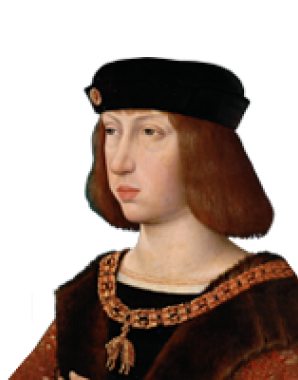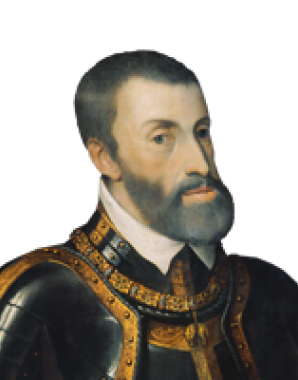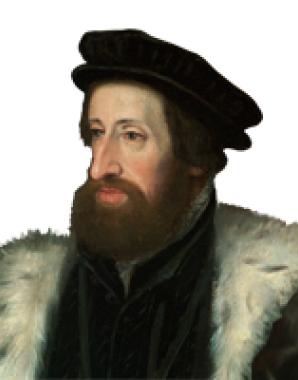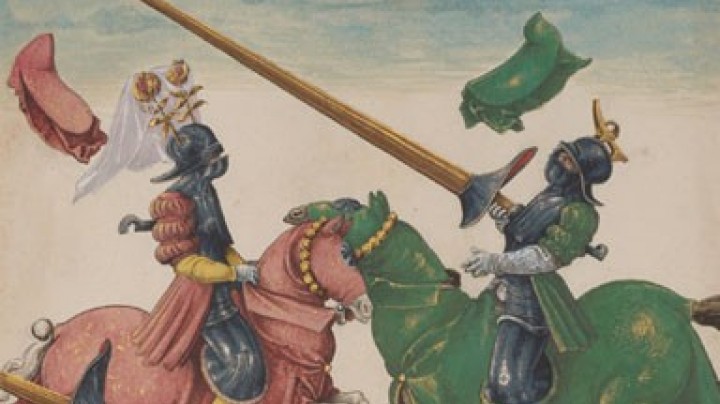Joan the Mad as the progenitrix of the Spanish and Austrian Habsburgs
The marriage of Joan and Philip the Fair resulted in six children. Their two sons Charles and Ferdinand became the founders of the two main lines of the dynasty.
The elder son Charles, born in Ghent in 1500, continued the Spanish line of the dynasty, while the younger son Ferdinand, born in Alcalá in Spain in 1503, founded the Austrian branch.
Like most of her siblings, their eldest daughter Eleonora, born in Brussels in 1498, grew up in the care of her paternal aunt, Archduchess Margaret, in the Netherlands. Eleonora was sacrificed by her brother Charles to the exigencies of politics. At the age of twenty-one she was married to King Manuel of Portugal, then aged fifty and already twice widowed. Both of Eleonora’s predecessors had been her aunts.
After two years she was widowed and again became the object of her brother’s nuptial policies. The French king Francis I had been held prisoner by Charles following the Battle of Pavia in 1525, and during his captivity a promise to marry Eleonora had been extracted from him. After his release in accordance with the terms of the Peace of Madrid in 1526 Francis revoked the agreement. It was not until the Peace of Cambrai, also known as the Peace of the Ladies, in 1529 that the marriage was finally agreed. It was however to remain childless. Eleonora died in 1558 in Spain, to where she had returned after her husband’s death.
Joan’s second daughter Isabella (1501–1526) was also sacrificed by her brother for the sake of a dynastic alliance, becoming the wife of King Christian of Denmark.
Even in her infancy Maria (1505–1558) had a significant role in the nuptial policy of her grandfather Maximilian I. She was to be married to the future Jagiello heir to the thrones of Hungary and Bohemia in affirmation of the Vienna agreement. The delicate issue here was that the latter had not yet been born. It was not until the birth of Louis II of Jagiello that her future bridegroom was certain. She was to marry him at the age of ten in the Viennese ‘double wedding’ of 1515. Maria grew up with her sister-in-law Anna in Innsbruck. In 1521 Maria travelled for the first time to Hungary to be united with her husband, who was one year her junior. During her brief marriage to Louis, who fell in the Battle of Mohács against the Turks in 1526, she demonstrated considerable political gifts, preparing the ground for her brother Ferdinand to assume the crowns of Hungary and Bohemia.
In 1530 Maria left Central Europe to take up the post of governor of the Netherlands. Her brother Charles knew he could count on her outstanding abilities in representing Habsburg interests against the influential Estates of the Netherlandish territories. During her governorship the Netherlands flourished, and the dynasty owed it to Maria that they were able to retain these rich territories over which she ruled with a sure hand. Her opinion carried considerable political weight within the family. Maria is regarded as one of the great female figures of the dynasty.
She resigned her offices in old age, spending her final years in Spain, where she died in 1558.
Joan’s youngest daughter, Catherine (1507–1578), was not born until after her father’s death. At first she accompanied her mother into monastic imprisonment, where she grew up in isolation, before her brother Charles V brought her to live at court. In 1524 he married his sister off to King John III of Portugal. Among the children of this union was Maria Manuela (1527–1545), the first wife of Catherine’s nephew Philip II. From 1557 to 1568 Catherine ruled with great skill in the stead of her grandson, the heir to the throne Dom Sebastian, who was still a minor.
















